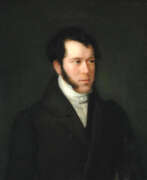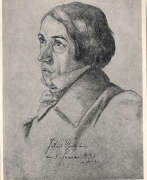Holy Roman Empire 19th century


Carl Gustav Carus was a German painter of the first half of the 19th century. He is known as a landscape painter, as well as a scientist, physician (gynecologist, anatomist, pathologist, psychologist) and a major theorist of Romanticism in art.
Carus created idyllic landscapes depicting moonlit nights, mountains, forests, Gothic architecture and ruins. In his work, according to critics, he combined a romantic view of nature with the classical ideal of beauty, understood the beautiful as a triad of God, nature and man. Noteworthy are his small-format, spontaneously created landscape sketches with images of clouds. The master is the author of "Nine Letters on Landscape Painting" - one of the main theoretical works that laid the foundations of the German Romantic school of painting.


Günther Gensler was a German artist of the mid-nineteenth century. He is known as a painter, draughtsman, graphic artist and printmaker, a representative of the Hamburg art school.
Gensler created more than 120 oil paintings and graphic works during his career. The most famous of them is the painting "Meeting of Members of the Hamburg Artists' Club" in 1840. The master began preparatory work on this group portrait in 1838.
In 2019, Gensler's works were part of the exhibition "The Hamburg School - Rediscovering the 19th Century" at the Hamburger Kunsthalle.


Johann Gerhard Huck was a German artist of the late eighteenth and early nineteenth centuries. He is known as a painter, draughtsman, graphic artist and copperplate engraver.
Huck early in his career worked at the Academy of Arts in Düsseldorf, then studied with the famous engraver Valentine Green in London. The master founded the Academy of Art in Hanover and was court engraver to the Hanoverian royal court. He was also a member of the Chalcographic Society of Dessau. Among his famous works is a portrait of Baron and patron of the arts Friedrich Moritz von Brabach.


Ferdinand Jagemann was a German painter of the first quarter of the 19th century. He is known as a painter and graphic artist, especially famous in portraiture.
Ferdinand Jagemann created many portraits of famous personalities of his time, including several portraits of Johann Wolfgang Goethe painted in 1805, 1806, 1817 and 1819, as well as Friedrich Schiller, whom he portrayed on his deathbed.


Joseph Kellerhoven was a German painter of the first half of the nineteenth century. He is known as a portrait painter, teacher, and as the son of another famous portrait painter, Moritz Kellerhoven.
Joseph Kellerhoven was mainly engaged in the creation of portraits, adhering to the style of his father. According to contemporaries, his work was distinguished by its excellent concept, a fine sense of color and a refined technique. The drawing lessons taught by the artist were also highly regarded. Kellerhoven also created religious paintings.


Franz Kobell was a German painter of the late 18th and early 19th centuries. He is known as a painter, draughtsman, architectural landscape painter, landscape painter, and brother of the artist Ferdinand Kobell.
Franz Kobell was court painter to the Elector Maximilian III of Bavaria. In addition to a small number of oil paintings, he produced more than 20,000 drawings of architectural landscape subjects, possessing the ability to work quickly and easily with pen and watercolor. His works ended up in various public and private collections.


Georg Emanuel Opiz was a German painter of the first half of the 19th century. He is known as a painter, graphic artist, printmaker and author of historical novels, publishing under the pseudonym Bohemius.
Opiz began his career with portraits, but from 1807 moved on to genre subjects. He became famous for his watercolors and gouaches depicting daily life in Paris during the Napoleonic I era. His series of lithographs "Cossacks in Paris", executed from life in 1814, became very famous. In 1819 he published a series of 24 color prints "Scenes of Characters from Life in Paris". In the 1820s, Opiz created a series of watercolors, presumably inspired by trips to Russia and the Ottoman Empire.


Johann Dominicus Quaglio was an Italian-born German painter of the first half of the 19th century. He is known as an architectural painter and graphic artist of the Romantic era, theater artist, lithographer and printmaker.
Quaglio traveled to various countries, which became a source of inspiration for his many works. He depicted medieval churches, castles, ruins and cities in his works. The master was one of the first to use lithography to recreate Gothic structures in graphic form. His works are historical and architectural documents of the time.
Quaglio was court painter to the Bavarian throne and a member of the Munich and Berlin Academies of Arts. He is considered by critics to have brought architectural painting back to a respectable level.


Lorenzo Quaglio was an Italian-born German painter of the first half of the 19th century. He is known as a painter, landscape painter, genre painter and lithographer of the German Biedermeier period, a member of the Quaglio dynasty of artists, brother of the famous architect-artist Domenico Quaglio.
Lorenzo Quaglio worked early in his career as a decorator for the court of the Bavarian Electorate and the national theater in Munich. He traveled frequently in the Bavarian and Tyrolean Alps, which inspired him to create. His works predominantly depicted scenes from the peasantry of Upper Bavaria. He also executed on stone copies of paintings from the Dresden Gallery. In 1812, he created his first lithograph with nature scenes, and from 1820 he studied Bavarian folk costume. Later he worked on the decoration of the Swan Knight Hall in Hohenschwangau Castle.


Friedrich Julius Ludwig Sebbers was a German painter of the first half of the nineteenth century. He is known as a portrait painter, porcelain artist and lithographer.
Ludwig Sebbers created portraits on porcelain and canvas, depicting members of ruling dynasties, cultural figures, and scholars. His lithographs for books became popular in 1835-1836. One of the artist's most famous works was a portrait of Johann Wolfgang Goethe for translation onto porcelain. Sebbers' pencil version of Goethe's portrait was later used for commemorative coins issued in Germany in 1932 in honor of the centenary of the poet's death.


Ludovike Simanowiz was a German portrait painter celebrated for her classical style and intimate depictions of her contemporaries. Born into a military family, her artistic talent was nurtured from an early age, despite the challenges women faced in accessing formal artistic education during the late 18th century. Through private lessons with Nicolas Guibal and later studies under Antoine Vestier in Paris, Ludovike Simanowiz honed her skills, enabling her to capture the essence of her subjects with sensitivity and depth. Her journey was marked by resilience; after fleeing Paris due to the revolution, she continued her art while supporting her family through teaching and commissions.
Ludovike Simanowiz's works, primarily portraits, are known for their emotional depth and technical precision, reflecting her experiences and the cultural milieu of her time. Her portraits of Friedrich Schiller and his family, alongside self-portraits and depictions of other notable figures, remain significant contributions to classical portraiture, capturing the intellectual and cultural vibrancy of her era. Despite the personal challenges she faced, including caring for her paralyzed husband, Simanowiz's legacy as a pioneering female artist endures, with many of her works residing in private collections and commemorated in the Municipal Museum of Schorndorf.
Her story is not just one of artistic achievement but also of perseverance in the face of societal constraints, making her an inspiring figure in the history of art. Collectors and art experts continue to value her contributions to the European art scene, recognizing her as a significant figure in late 18th-century art.
For collectors and experts in art and antiques, Ludovike Simanowiz's oeuvre offers a fascinating glimpse into the artistic and cultural history of her time. Her life's work demonstrates the remarkable ability of art to capture the human spirit, making her portraits highly sought after for both their historical significance and artistic merit.
To stay informed about new discoveries, sales, and auction events related to Ludovike Simanowiz's work, signing up for updates is essential. This subscription ensures access to the latest information, allowing collectors and enthusiasts to remain at the forefront of developments in the world of art and antiques related to this remarkable artist.


Julius Thaeter was a German painter of the mid-nineteenth century. He is known as a copperplate engraver and reproductionist.
Julius Thaeter created engravings that became famous for their meticulous execution, moderate shading, and accurate reproduction of original works by artists. Among his major works are "The Battle of the Huns" and "The Pandemonium of Babylon" (reproduction by Kaulbach), "Hrimgild and the Corpse of Siegfried" (Schnorr), "The Soul Carrier Charon" and "Parks" (Karstens), "Feats of Mercy of St. Elizabeth, Queen of the Holy Land" (Kaulbach), "The Works of Mercy of St. John the Baptist" (Kaulbach), "The Battle of the Huns" and "The Battle of Babylon" (Kaulbach). St. Elizabeth, Queen of Hungary" (M. von Schwind), illustrations to psalms (G. König), and reproductions of paintings by Cornelius and Raphael.


Maria Elisabeth Vogel (née Maria Elisabeth Timmermann) was a German painter of the last quarter of the 18th and early 19th centuries. She is known as a portrait painter of the classicist era.
Maria Elisabeth Vogel is most famous for a generational portrait of the poet Friedrich Gottlieb Klopstock, which she exhibited in Hamburg after his death in 1803. The painting was acquired by the "Patriotic Society" and is now in the Hamburg History Museum. The artist also created paintings with religious content for churches.


Christian Leberecht Vogel was a German painter of the late eighteenth and early nineteenth centuries. He is known as a painter, draughtsman, and art theorist.
Vogel was particularly famous for his skill in creating portraits of children. He also painted portraits commissioned by aristocratic families and taught painting at the Academy of Art in Dresden. His artistic legacy is preserved in the Dresden Art Gallery. Vogel is still appreciated for his humanistic approach to depicting human feelings in his works, which are characterized by expressiveness and sensuality.
His son Carl Christian Vogel von Vogelstein also became court painter of Saxony and received a noble title for his services.


Wilhelm von Kobell was a German painter of the first half of the 19th century. He is known as a landscape painter, animalist and battle painter.
Von Kobell initially produced landscapes and animal paintings, but later focused mainly on battle painting. He visited Vienna and Paris between 1809 and 1810 to study this genre. His battle paintings, based on extensive research, are characterized by striking realism. They are important for the study of military history.


Friedrich Georg Weitsch was a German painter of the late 18th and early 19th centuries. He is known as a painter and printmaker.
Weitsch created landscapes, historical and religious subjects, but a special place in his work was occupied by portraits of aristocrats, as well as ordinary people. His works are in various museums, including the Braunschweig City Museum, the Braunschweig Land Museum, and the Duke Anton Ulrich Museum of Braunschweig-Wolfenbüttel.



